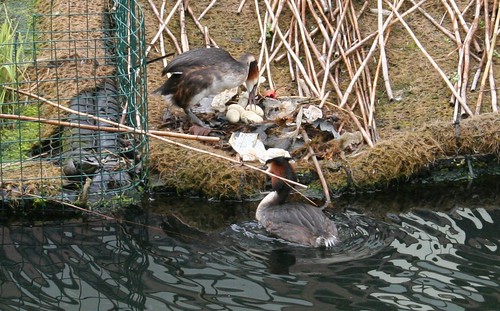The biological species concept is one of the more well known models and although it centers around several pieces of evidence, the core piece deals with reproductive isolation. We've discussed this idea a little in the past when talking about the African Cichlid fish and again last time, in part, with the ring species example. This isolation however, has many parts to it. For the sake of simplicity, we'll talk about two general sections
- Pre-zygotic isolation: Isolation that occurs before the completion of the zygote. At the risk of over-generalizing and simplifying we'll refer to this as pre-mating. These are the things most people think of-mate choice, mate and species recognition, behavior, etc.
- Post-zygotic isolation: This isolation is a little less well known and can be a little more difficult to understand. These are isolations that occur AFTER mating, basically penalties for poor mate choice. Generally these refer future of the offspring. This can be things like zygote mortality, sterile young (cannot produce offspring of their own like a mule), or a poor mix of adaptations (mom is adapted to one and dad is adapted to another and the middle ground isn't well adapted to anything).
The thing I want to reinforce here is that speciation is in fact a PROCESS by which species come about. Usually you see these species first experience some post-zygotic isolation that will be reinforced by pre-zygotic isolation. Generally a species isn't truly called until there is no survival of any young and that there is no choice mating between the different populations.
Now the ecological concept seems a little more straight forward. The idea here is that the species experience isolation based on their ecological niche, things like habitat choice, nesting, food choice, life-cycle and timing. An example would be birds that choose marshier habitat and those that choose higher ground, dry habitat. Different habitat and attracting different partners, thusly reducing the change of cross breeding. Here you consider that the species are now filling (or starting to fill) different ecological roles.

As you can imagine as straight forward as this can be (to breed or not to breed) there is a lot of space for haziness too. With a shifting environment and climate you can be on the brink of isolation and suddenly end up with hybrids between the populations that are even more well adapted than either of their parents. There are plenty of cases where, as with the ring species example, although you can identify clear separate species, they are not finite and have hazy zones in the long line that got them there. So where do we draw the line? If we are more strict we lose the potential to understand discrete ecological impacts and in some cases destroy chances of species or populations of receiving government protection because they they don't qualify under endangerment laws. If we are more flexible with our definitions we get widespread confusion and, as some birders and avian biologists can tell you, infinite updates on what species are and which are mere groups. And, as I mentioned in the last speciation post, you get some cranky extreme creationists that run with it like it's on fire. So what do you think? What is a species?

Feel free to post with your comments, this is a controversial and ever changing topic! I'm happy to discuss! I have the book I referenced and some additional sources from a class I took!
Until next time!
"It is by universal misunderstanding that all agree. For if, by ill luck, people understood each other, they would never agree." Charles Baudelaire
No comments:
Post a Comment